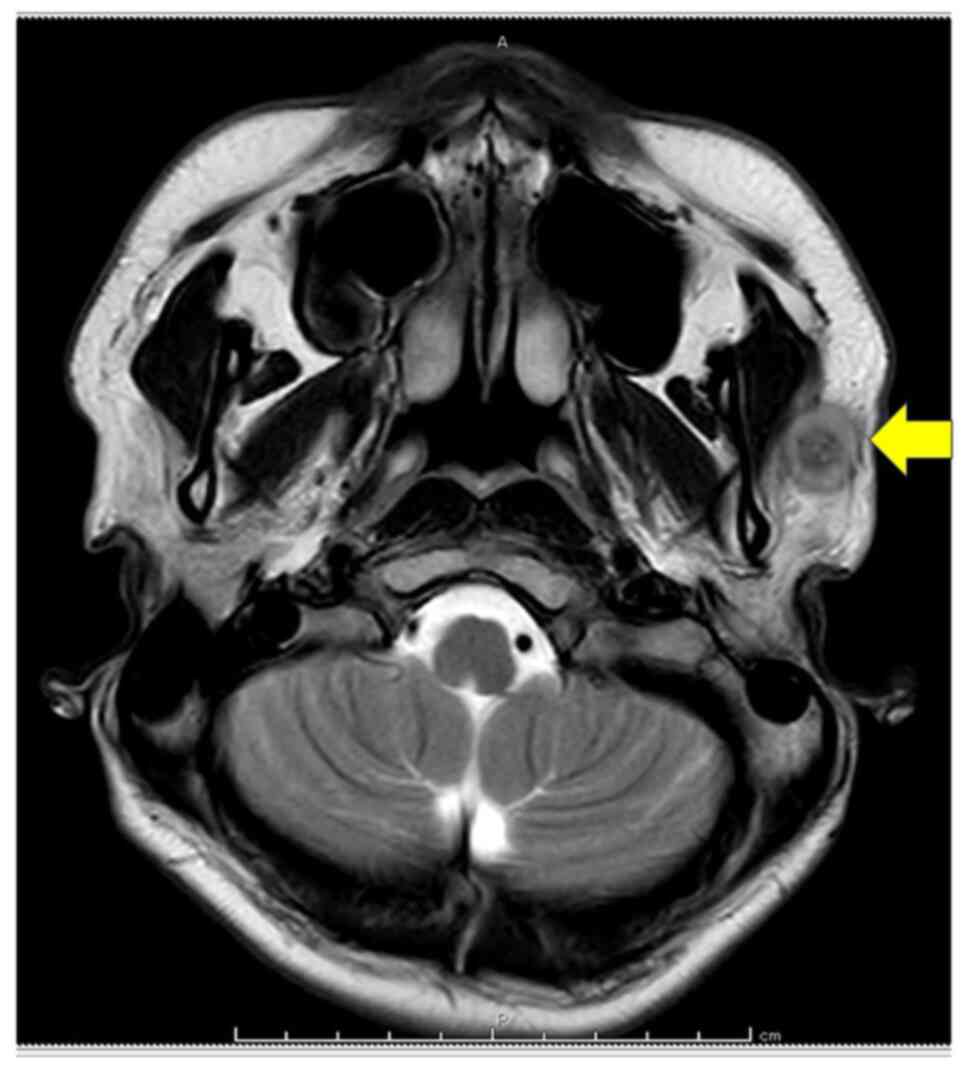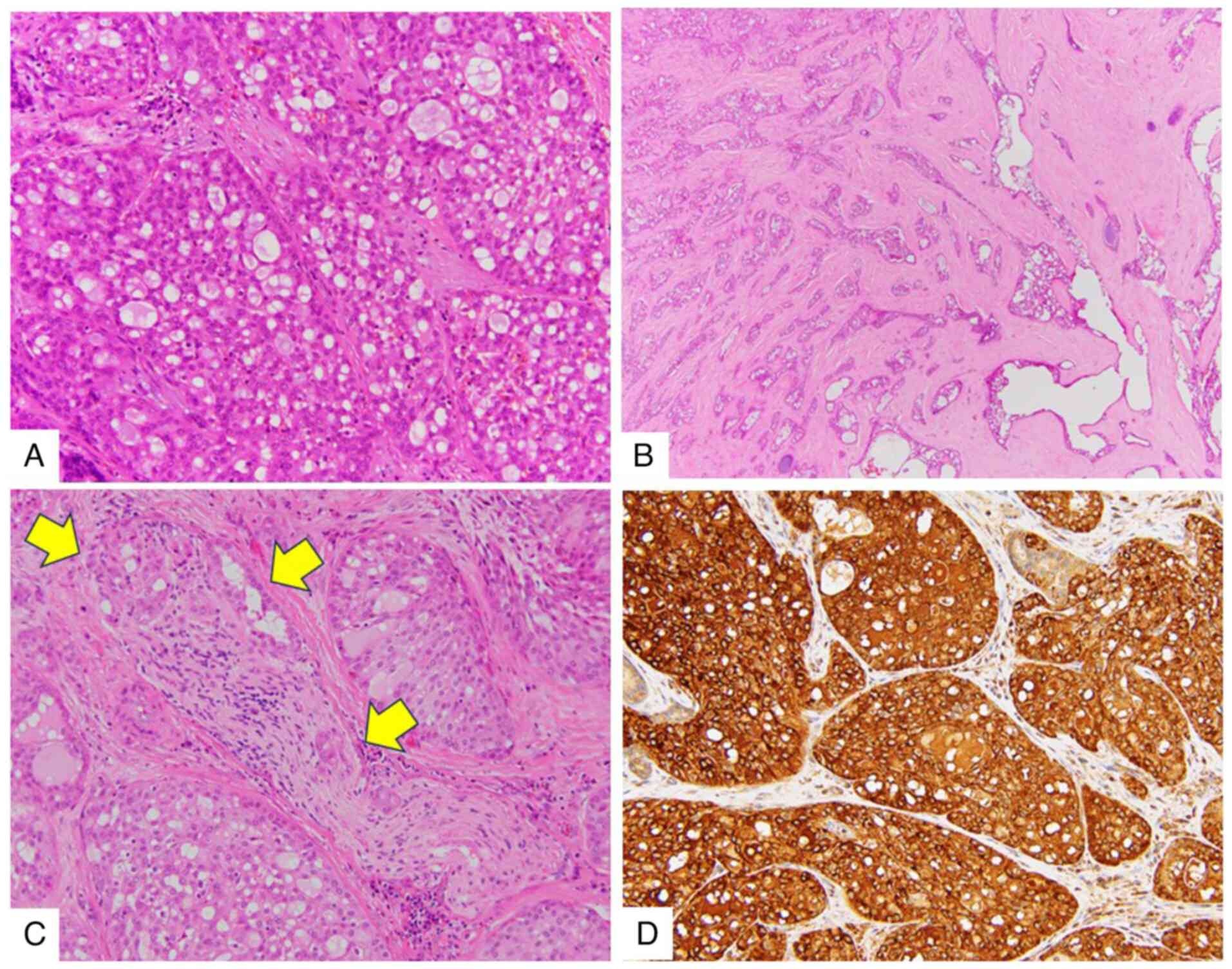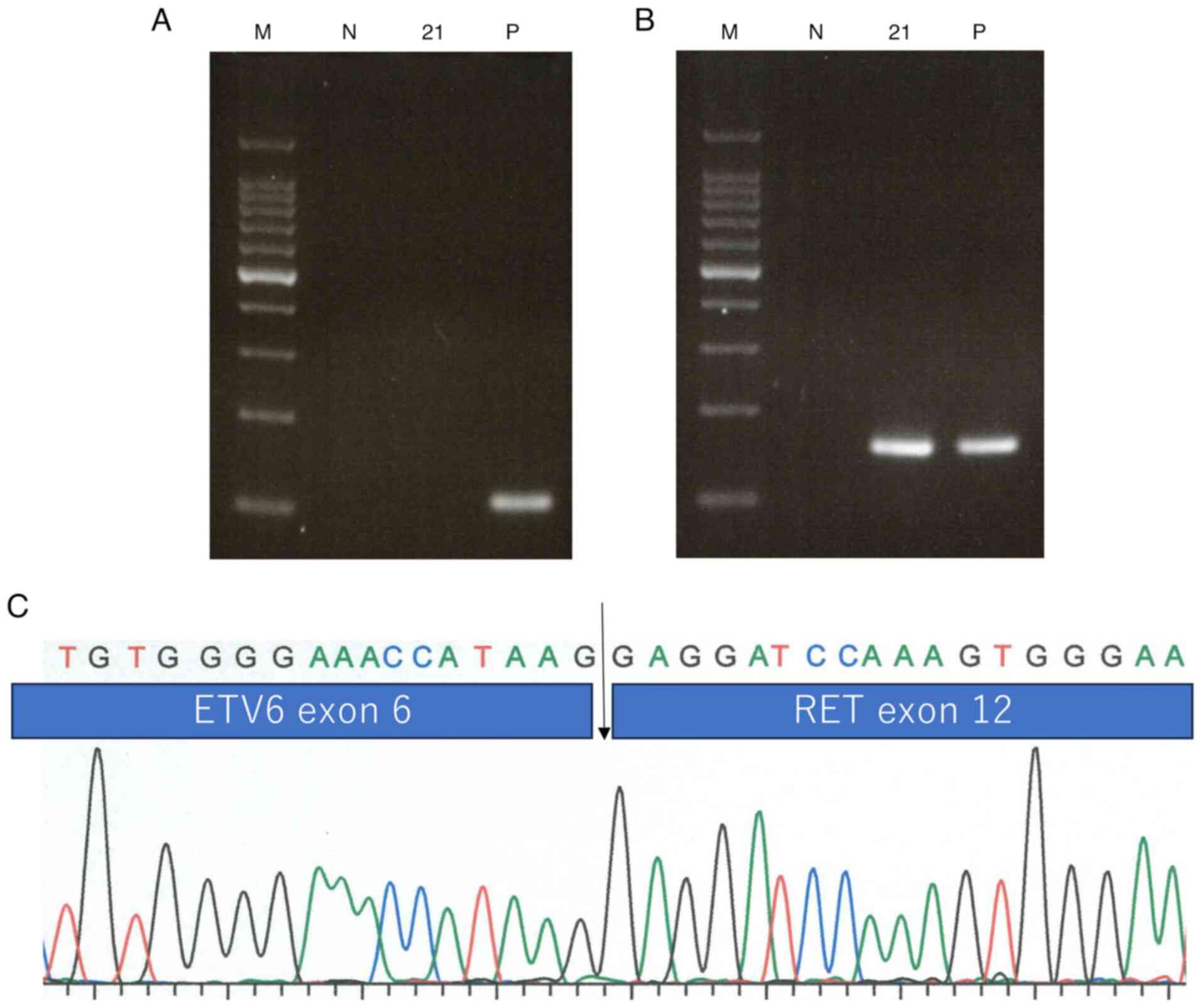|
1
|
Skálová A, Vanecek T, Sima R, Laco J,
Weinreb I, Peres-Ordonez B, Starek I, Geierova M, Simpson RHW,
Passador-Santos F, et al: Mammary analogue secretory carcinoma of
salivary glands, containing the ETV6-NTRK3 fusion gene: A hitherto
undescribed salivary gland tumor entity. Am J Surg Pathol.
34:599–608. 2010.PubMed/NCBI View Article : Google Scholar
|
|
2
|
Cocco E, Scaltriti M and Drilon A: NTRK
fusion-positive cancers and TRK inhibitor therapy. Nat Rev Clin
Oncol. 15:731–747. 2018.PubMed/NCBI View Article : Google Scholar
|
|
3
|
Skalova A, Vanecek T, Martinek P, Weinreb
I, Stevens TM, Simpson RHW, Hyrcza M, Rupp NJ, Baneckova M, Michal
M Jr, et al: Molecular profiling of mammary analog secretory
carcinoma revealed a subset of tumors harboring a novel ETV6-RET
translocation. Report of 10 cases. Am J Surg Pathol. 42:234–246.
2018.PubMed/NCBI View Article : Google Scholar
|
|
4
|
Guilmette J, Dias-Santagata D, Nose V,
Lennerz JK and Sadow PM: Novel gene fusions in secretory carcinoma
of the salivary glands: Enlarging the ETV6 family. Hum Pathol.
83:50–58. 2019.PubMed/NCBI View Article : Google Scholar
|
|
5
|
Drilon A, Hu ZI, Lai GGY and Tan DSW:
Targeting RET-driven cancers: Lessons from evolving preclinical and
clinical landscapes. Nat Rev Clin Oncol. 15:151–167.
2018.PubMed/NCBI View Article : Google Scholar
|
|
6
|
Skalova A, Bishop JA, Kholova I and Urano
M: Secretory carcinoma. In: WHO Classification of Tumours. 5th
edition. International Agency for Research on Cancer, Lyon,
pp210-212, 2024.
|
|
7
|
Ito Y, Ishibashi K, Masaki A, Fujii K,
Fujiyoshi Y, Hattori H, Kawakita D, Matsumoto M, Miyabe S,
Shimozato K, et al: Mammary analogue secretory carcinoma of
salivary glands: A clinicopathologic and molecular study including
2 cases harboring ETV6-X fusion. Am J Surg Pathol. 39:602–610.
2015.PubMed/NCBI View Article : Google Scholar
|
|
8
|
Skálová A, Vanecek T, Simpson RHW, Laco J,
Majewska H, Baneckova M, Steiner P and Michal M: Mammary analogue
secretory carcinoma of salivary glands. Molecular analysis of 25
ETV6 gene rearranged tumors with lack of detection of classical
ETV6-NTRK3 fusion transcript by standard RT-PCR: Report of 4 cases
harboring ETV6-X gene fusion. AmJ Surg Pathol. 40:3–13.
2016.PubMed/NCBI View Article : Google Scholar
|
|
9
|
Wang Y, Sun J, Sun B, Zhang C, Tian Z,
Wang L and Li J: The genetic and immune features of salivary gland
secretory carcinoma with high-grade transformation. Oral Dis.
30:4320–4330. 2024.PubMed/NCBI View Article : Google Scholar
|
|
10
|
von Bergh ARM, van Drunen E, van Wering
ER, van Zutven LJCM, Hainmann I, Lönnerholm G, Meijerink JP,
Pieters R and Beverloo HB: High incidence of t(7;12)(q36;p13) in
infant AML but not in infant ALL, with a dismal outcome and ectopic
expression of HLXB9. Genes Chromosomes Cancer. 45:731–739.
2006.PubMed/NCBI View Article : Google Scholar
|
|
11
|
Yokota T, Yukino H, Doi M and Ohori H:
Real-world experience of tropomyosin receptor kinase inhibition
with entrectinib in ETV6-NTRK3 positive metastatic salivary
secretory carcinoma: A case series. Head Neck. 45:E10–E15.
2023.PubMed/NCBI View Article : Google Scholar
|
|
12
|
Moriyama E, Nagasu S, Tanaka T,
Shimotsuura Y, Ono T, Umeno H, Akiba J, Kawahara A, Fujita F,
Kawaguchi T and Miwa K: Case report: A case of complete response to
entrectinib in NTRK fusion gene-positive parotid gland cancer.
Front Oncol. 13(1247435)2023.PubMed/NCBI View Article : Google Scholar
|
|
13
|
Subbiah V, Cassier PA, Siena S, Garralda
E, Paz-Ares L, Garrido P, Nadal E, Vuky J, Lopes G, Kalemkerian GP,
et al: Pan-cancer efficacy of pralsetinib in patients with RET
fusion-positive solid tumors from the phase 1/2 ARROW trial. Nat
Med. 28:1640–1645. 2022.PubMed/NCBI View Article : Google Scholar
|
|
14
|
Black M, Liu CZ, Onozato M, Iafrate AJ,
Darvishian F, Jour G and Cotzia P: Concurrent identification of
novel EGFR-SEPT14 fusion and ETV6-RET fusion in secretory carcinoma
of the salivary gland. Head Neck Pathol. 14:817–821.
2020.PubMed/NCBI View Article : Google Scholar
|
|
15
|
Smith ME, Surrey LF, Zhang PJ, Weinstein
GS and LiVolsi VA: Molecular identification of an ETV6-RET fusion
in a secretory carcinoma associated with a pleomorphic adenoma.
Oral Surg Oral Med Oral Pathol Oral Radiol. 134:733–738.
2022.PubMed/NCBI View Article : Google Scholar
|
|
16
|
Salgado CM, Alaggio R, Reyes-Mugica M, Zin
A and de Vito R: Clinicopathologic and molecular characterization
of four cases of pediatric salivary secretory carcinoma (SSC), one
with ETV6-RET fusion. Head Neck Pathol. 15:796–802. 2021.PubMed/NCBI View Article : Google Scholar
|
|
17
|
Su YJ, Lee YH, Jin YT and Hsieh MS: Using
pan-TRK and RET immunohistochemistry for the detection of fusion
types of salivary gland secretory carcinoma. Appl Immunohistochem
Mol Morphol. 30:264–272. 2022.PubMed/NCBI View Article : Google Scholar
|
|
18
|
Baněčková M, Thompson LDR, Hyrcza MD,
Vaněček T, Agaimy A, Laco J, Simpson RHW, Di Palma S, Stevens TM,
Brcic L, et al: Salivary gland secretory carcinoma:
Clinicopathologic and genetic characteristics of 215 cases and
proposal for a grading system. Am J Surg Pathol. 47:661–677.
2023.PubMed/NCBI View Article : Google Scholar
|
|
19
|
Wang J, Li R, Li J, Yi Y, Liu X, Chen J,
Zhang H, Lu J, Li C, Wu H and Liang Z: Comprehensive analysis of
oncogenic fusions in mismatch repair deficient colorectal
carcinomas by sequential DNA and RNA next generation sequencing. J
Transl Med. 19(433)2021.PubMed/NCBI View Article : Google Scholar
|













